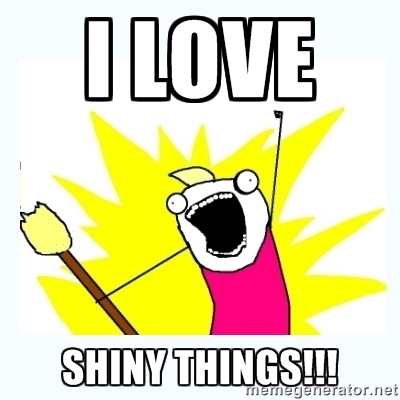Designers and developers, by their nature I think, are attracted to new things if for no other reason than to see how it’s designed, how it’s put together, how it functions, and so on. I don’t consider that a positive or a negative – it’s just a trait that some people have (and certain types of people exhibit it more than others).

That curiosity matched with the desire to constantly be improving at one does do for a living (or for a hobby) is what separates those who see the gig as “just a job” and those who see it as what they’re dedicating their lives to doing.
Yes – it can be expensive: Some like to purchase new devices as soon as they are released or new products as soon as they are released in order to familiarize themselves with them, and then to try to bring back what they’ve seen, learned, and experienced and build it into whatever they’re focused on creating.
But when you bring this approach into something like WordPress theme design and/or theme development, it has the obvious potential to improve future work but it can also negatively impact existing work.
New and Different WordPress Themes
As much time, effort, work, and marketing we like to do around WordPress themes, I think the typical customer sees shopping for a WordPress theme as shopping for a look for their blog.
Sure, some are looking for a theme that fits the type of content they are publishing or the format in which they’re publishing said content, but I think that for those who are looking for a theme for they’re blog, they’re simply looking for something that appeals to them.
So let’s say that a person finds a theme that they like, they purchase it, and they activate it on their blog. At this point, they’re likely to configure a few plugins, maybe make some customizations using minor CSS edits, and then begin writing.
Over time, it’s reasonable to expect updates for a given theme to make sure that it stays compliant with WordPress, adopts the proper trends for the web, and generally keeps the functionality of the blog as current as possible.
But when we mix the desire to provide a “major update” to the way a theme looks, we’re changing the very thing that gives a theme its identity, and we’re essentially giving customers a completely different WordPress theme than the one they’ve purchased.
Yikes. Surprised (and disappointed, even).
https://www.youtube.com/watch?v=A9gC1GiSDDA
It’s hard to think of an industry in which it’s acceptable – let alone standard – to go buy a product at one point only to have it completely change when the next iteration is released. I know – in some cases, this would be nice – but not in all cases, and themes are like that.
To that end, when creating, marketing, selling, and updating WordPress themes, it’s important to handle cosmetic updates with care.
As much fun as it is to work with some of the latest trends in the web, or new libraries, or experimental browser APIs, and so on, customers don’t necessarily need, want, or even care about what we think may be useful in a theme. Once a user purchases and activates a theme, they’re activating what they saw and experienced when they purchased the theme.
Drastically changing up the theme is like giving a person a different product.


Leave a Reply
You must be logged in to post a comment.